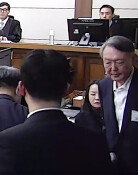TK→PK→Honam Figures, Targets for Audit and Inspection Following the Ruling Government
TK→PK→Honam Figures, Targets for Audit and Inspection Following the Ruling Government
Posted January. 13, 2005 22:55,
The audit and inspection sword is a temptation hard to turn away from to the force in power. Regardless of the time, the force in power has consolidated its power base by changing the political and social atmosphere through a large-scale audit and inspection during the beginning of a government that has just launched or in a critical situation, and attempting to change the leading force.
After 1993, our societys ruling power underwent three changes based on regional foundation. The Kim Young-sam (YS) government and Kim Dae-jung (DJ) government showed strong regional colors and the current Roh Moo-hyun government also shows regional colors to some level.
The analysis of the audit and inspection results by the Dong-A Ilbo reporters shows that there is a functional relation between these governments and the targets for the audit and inspection.
During the YS government, with its base in the Pusan/Kyeongnam (PK) area, the targets brought up for audit and inspection were concentrated on major figures from the Taegu/Kyeongbuk (TK) area, which was the previous ruling power.
Among the 464 people analyzed, a total 131 people (politicians, high-ranking public officials, heads of local governments, executives of public enterprises, those with legal profession, and etc.) were charged during the YS government (1993~1997). Classifying these people by their hometown, those from TK comprised the most with 36 people (27.4 percent). On the other hand, those from PK comprised 17 (12.9 percent) and Honam had 18 (13.7 percent).
At the peak of the audit and inspection during the PK government, the words There are even no wings for the falling TK went about among the prosecution, insinuating the situation where many TK figures having key positions in the TK government were arrested. These words are proved that it was not just a joke.
After the DJ government, with its Honam district base, launching, PK figures followed the same steps of the TK figures who had given up their positions to them.
One hundred seventy-five major figures were charged during the DJ government (1998~2002). During this period, the number (33 people) and rate (18.9 percent) of TK figures dropped compared to the PK government. On the other hand, the number (31 people) and rate (17.7 percent) of PK figures increased greatly.
The interesting matter is that 35 major figures (20.0 percent) from the Honam district were brought up as targets for audit and inspection in the DJ government. This seems to be from the various gate cases at the end of the DJ government, in which many in the ruling power went through investigation.
After the Roh Moo-hyun government launched in 2003, many major figures were brought up for audit and inspection with the investigation into presidential campaign funds.
The major figures for audit and inspection during the two years, from 2003 to the end of 2004, are grasped to be some 158 people. Among them, those from the Honam district comprised the most with 46 (29.1 percent) people. TK members (24 people, 15.2 percent) are in a downward trend, and PK members (22 people, 13.9 percent) have dropped significantly compared to the past.
These results show that when a government changes, the power elites from the previous government are intensely brought up as targets for audit and inspection, and their empty places are taken by the power elites from the new government. When the government changes, this same situation repeats.
For this reason, suspicions have been brought up for the intentions of audit and inspection that it has lost its original pure intention and is deteriorating into a target audit and inspection aimed at the previous ruling power.
However, this does not mean that those targets for audit and inspection will be pardoned. Whatever the motive for the audit and inspection was, it is their corruption or violation of the law which has given the cause for the audit and inspection.





![[단독]李대통령 中 향한 날…北 23차례 항공기 GPS 교란했다](https://dimg.donga.com/c/138/175/90/1/wps/NEWS/IMAGE/2026/01/16/133172641.1.jpg)
![“설거지해도 그대로”…냄비 ‘무지개 얼룩’ 5분 해결법 [알쓸톡]](https://dimg.donga.com/c/138/175/90/1/wps/NEWS/IMAGE/2026/01/15/133164664.3.png)
